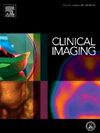人工智能模型在胸部 X 光检测气胸方面的诊断性能。
IF 1.8
4区 医学
Q3 RADIOLOGY, NUCLEAR MEDICINE & MEDICAL IMAGING
引用次数: 0
摘要
目的:气胸(PTX)是一种常见的临床急症,其诊断通常是通过胸部X光检查(CXR)进行的,人工智能(AI)方法可以在这种情况下帮助放射科医生应对日益增加的工作量。因此,我们研究的目的是测试一个在 CXR 检查中检测 PTX 的人工智能系统,以审查其在这种情况下与放射科医生的诊断性能:方法:我们对因怀疑患有 PTX 而接受造影检查的患者的 CXR 检查进行了回顾性人工智能系统测试,这些患者在同一天还接受了计算机断层扫描(CT)检查,后者被用作参考标准。将所建议的人工智能系统的性能与阅片放射科医生从 CXR 报告中获得的性能进行了比较:总体而言,人工智能系统的准确率为 74%(95%CI 68-79%),灵敏度为 66%(95%CI 59-73%),特异性为 93%(95%CI 85-97%)。人类读者的准确率相当(77 %,95%CI 71-82 %,p = 0.355),灵敏度较高(73 %,95%CI 66-79 %,p = 0.040),但特异性较低(85 %,95%CI 75-91 %,p = 0.034)。人工智能的性能受患者进行 CXR 检查时的体位影响(p = 0.040):结论:所提出的工具可帮助放射科医生检测 PTX,提高特异性。通过对更具挑战性的病例进行培训来进一步改进该工具,可为其作为筛查工具或独立工具使用铺平道路。本文章由计算机程序翻译,如有差异,请以英文原文为准。
Diagnostic performance of an artificial intelligence model for the detection of pneumothorax at chest X-ray
Purpose
Pneumothorax (PTX) is a common clinical urgency, its diagnosis is usually performed on chest radiography (CXR), and it presents a setting where artificial intelligence (AI) methods could find terrain in aiding radiologists in facing increasing workloads. Hence, the purpose of our study was to test an AI system for the detection of PTX on CXR examinations, to review its diagnostic performance in such setting alongside that of reading radiologists.
Method
We retrospectively ran an AI system on CXR examinations of patients who were imaged for the suspicion of PTX, and who also underwent computed tomography (CT) within the same day, the latter being used as reference standard. The performance of the proposed AI system was compared to that of reading radiologists, obtained from CXR reports.
Results
Overall, the AI system achieved an accuracy of 74 % (95%CI 68–79 %), with a sensitivity of 66 % (95%CI 59–73 %) and a specificity of 93 % (95%CI 85–97 %). Human readers displayed a comparable accuracy (77 %, 95%CI 71–82 %, p = 0.355), with higher sensitivity (73 %, 95%CI 66–79 %, p = 0.040), albeit lower specificity (85 %, 95%CI 75–91 %, p = 0.034). The performance of AI was influenced by patient positioning at CXR (p = 0.040).
Conclusions
The proposed tool could represent an aid to radiologists in detecting PTX, improving specificity. Further improvement with training on more challenging cases may pave the way for its use as a screening or standalone tool.
求助全文
通过发布文献求助,成功后即可免费获取论文全文。
去求助
来源期刊

Clinical Imaging
医学-核医学
CiteScore
4.60
自引率
0.00%
发文量
265
审稿时长
35 days
期刊介绍:
The mission of Clinical Imaging is to publish, in a timely manner, the very best radiology research from the United States and around the world with special attention to the impact of medical imaging on patient care. The journal''s publications cover all imaging modalities, radiology issues related to patients, policy and practice improvements, and clinically-oriented imaging physics and informatics. The journal is a valuable resource for practicing radiologists, radiologists-in-training and other clinicians with an interest in imaging. Papers are carefully peer-reviewed and selected by our experienced subject editors who are leading experts spanning the range of imaging sub-specialties, which include:
-Body Imaging-
Breast Imaging-
Cardiothoracic Imaging-
Imaging Physics and Informatics-
Molecular Imaging and Nuclear Medicine-
Musculoskeletal and Emergency Imaging-
Neuroradiology-
Practice, Policy & Education-
Pediatric Imaging-
Vascular and Interventional Radiology
 求助内容:
求助内容: 应助结果提醒方式:
应助结果提醒方式:


